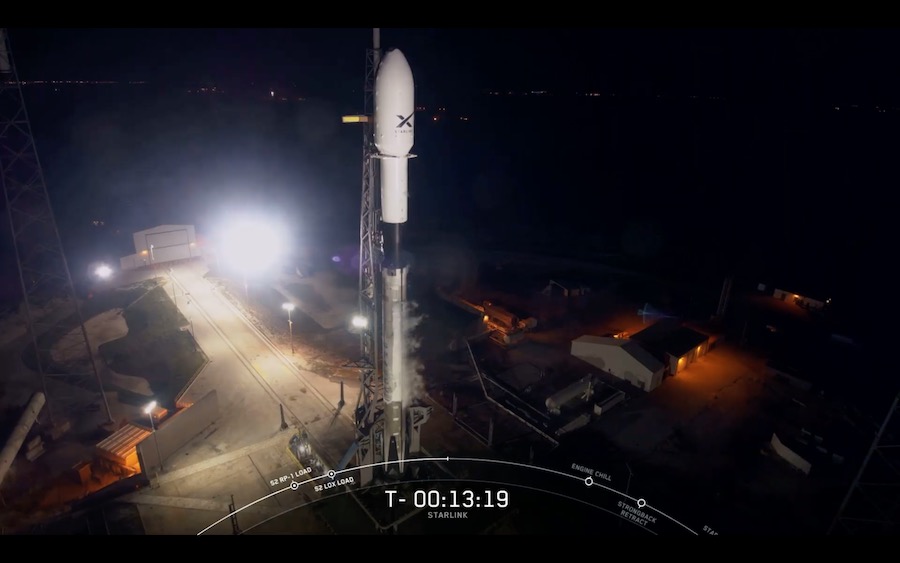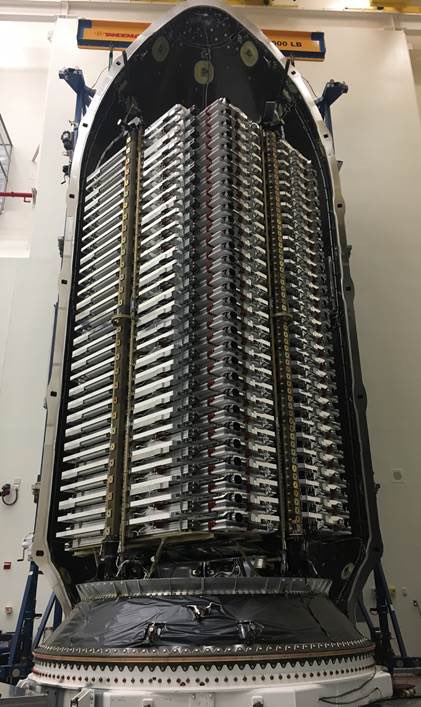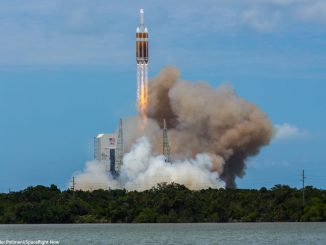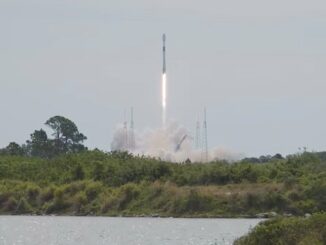
For the second consecutive day, SpaceX called off a Falcon 9 launch attempt at Cape Canaveral on Thursday evening, this time to complete a software update on the first 60 satellites for the company’s Starlink network to provide high-speed Internet service from orbit.
SpaceX cancelled Thursday night’s launch attempt, which was set for 10:30 p.m. EDT (0230 GMT Friday), around three hours before the opening of the launch window.
In a tweet, the company said it was “standing down to update satellite software and triple-check everything again.”
The payload awaiting launch on the Falcon 9 rocket consists of 60 flat-panel satellites to begin building out SpaceX’s Starlink network, a fleet that could number thousands of small spacecraft in the coming years, providing broadband connectivity to consumers around the world.
SpaceX did not set a new launch date for the mission, the first Falcon 9 launch dedicated to the Starlink project.
“Always want to do everything we can on the ground to maximize mission success, next launch opportunity in about a week,” SpaceX tweeted.
SpaceX scrubbed a previous countdown Wednesday night due to out-of-limits upper level winds.
The 60 satellites aboard the Falcon 9 were built in a new SpaceX factory in Redmond, Washington. The spacecraft are equipped with high-power phased array antennas to broadcast Internet signals and krypton ion thrusters for propulsion.
The Falcon 9 rocket will release the satellites, which each weigh about 500 pounds (227 kilograms), into orbit around an hour after liftoff from Cape Canaveral.
The 60 satellites will separate from the Falcon 9’s upper stage in a unique fashion, according to Elon Musk, SpaceX’s founder and CEO.
“It will be a little bit different looking deployment than people are used to,” Musk told reporters Wednesday in a conference call. “It’s going to be a very slow deployment where we rotate the stage, and each of the satellites on the stack has a slightly different amount of rotational inertia.
“So there’s not actually a spring-based or specific deployment mechanism per satellite,” he said. The satellites will kind of be deployed, it’s almost like spreading a deck of cards on a table. This will be kind of weird compared to normal satellite deployments.”
Multi-payload dispensers launched atop rockets typically release satellites in pairs, or one at a time, with a physical separation mechanism, such as a spring or pyrotechnic bolts.
SpaceX’s webcast will show the deployment through the view of a camera mounted on the rocket’s upper stage.
“There actually may be a small amount of contact between the satellites, but it’s very, very slow, and the satellites are designed to handle it,” Musk said. “But we wanted to avoid having 60 different deployment mechanisms for the satellites. We expect them to turn on shortly after deployment. They’ll start warming up the ion drive and go through a bunch of health checks.”
The 60 Starlink satellites are based on a new design conceived by SpaceX engineers. They are lighter and use a different separation scheme than two prototype Starlink satellites SpaceX launched last year.
“We should know if they’re in good shape probably about two or three hours after deployment, so three or four hours after launch,” he said.
The Falcon 9 launch will aim to release the Starlink satellites around 273 miles (440 kilometers) above Earth, and the spacecraft’s own thrusters will raise their orbits to 341 miles (550 kilometers) to begin technology demonstration trials.

“This is one of the hardest engineering projects I’ve ever seen done, and it’s been executed really well,” Musk said. “There is a lot of new technology here, and it’s possible that some of these satellites may not work, and in fact a small possibility that all the satellites will not work.
“We don’t want to count anything until it’s hatched, but these are, I think, a great design and we’ve done everything we can to maximize the probability of success,” he said.
Past initiatives to create an expansive communications satellite network in low Earth orbit, a regime a few hundred miles above Earth, have met technical and financial headwinds. Traditional communications satellites fly in higher geostationary orbits more than 22,000 miles (nearly 36,000 kilometers) above the equator, with a single spacecraft covering a wide geographic region.
In lower orbits, the Starlink satellites will bounce signals from user-to-user via an intricate web of radio connections through ground stations, and eventually through inter-satellite laser cross-links.
“The goal of the Starlink system is to provide high bandwidth, low latency connectivity, ideally throughout the world provided we get regulatory approval, and this would provide connectivity to people that don’t have any connectivity today, or where it’s extremely expensive and unreliable as well as providing options for people who may have connectivity today in developed areas of the world but it’s very expensive,” Musk said. “This will provide a competitive option for them.”
Starlink is one of several companies working on constellations of small broadband satellites in low Earth orbit. OneWeb launched its first six satellites in February, with plans to send hundreds more into orbit over the next two years, and Amazon says it plans to build a network consisting of thousands of satellites for Internet service.
“There’s a lot of fundamental goodness about Starlink,” he said. “We just want to make sure the appropriate caveats are there. There’s a lot of technology, this is very hard, and quite frankly in the past, the success of low-Earth orbit communications constellations, I believe none have successfully gone into operation without going bankrupt.”
SpaceX has secured regulatory approval from the Federal Communications Commission for nearly 12,000 Starlink satellites broadcasting in Ku-band, Ka-band and V-band frequencies, with groups of spacecraft positioned at different altitudes in low Earth orbit. But the early focus is on launching hundreds of the satellites to establish a network that covers most of the world’s population.
“It’s important to distinguish between initial operational capability, which is around the 400-satellite level, and then significant operational capability is around 800-satellite level, and thereafter, it’s about adding more and more satellites and more orbital planes of satellites as we get more usage of the system and we get bandwidth constrained,” Musk said. “One does not need anywhere near 10,000 satellites to be effective. … We’ll start selling service initial around the 400th satellite launch and then make sure our production and launch of satellites stays ahead of user demand.”
After the first Starlink launch, SpaceX plans between two and six additional Starlink missions later this year to begin building out the first phase of the network in orbit 341 miles above Earth, according to Gwynne Shotwell, SpaceX’s president and chief operating officer.
“This next batch of satellites will really be a demonstration set for us to see the deployment scheme and start pulling our network together,” Shotwell said at an industry conference last week.
Email the author.
Follow Stephen Clark on Twitter: @StephenClark1.



